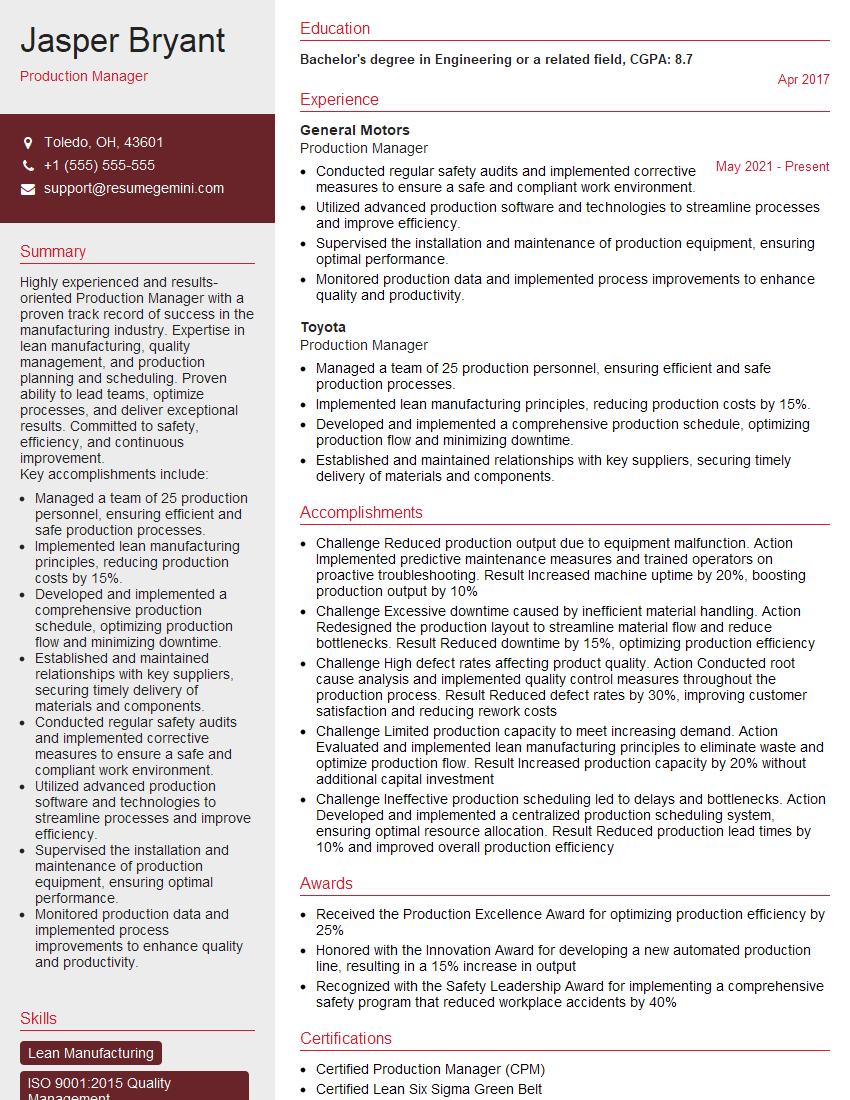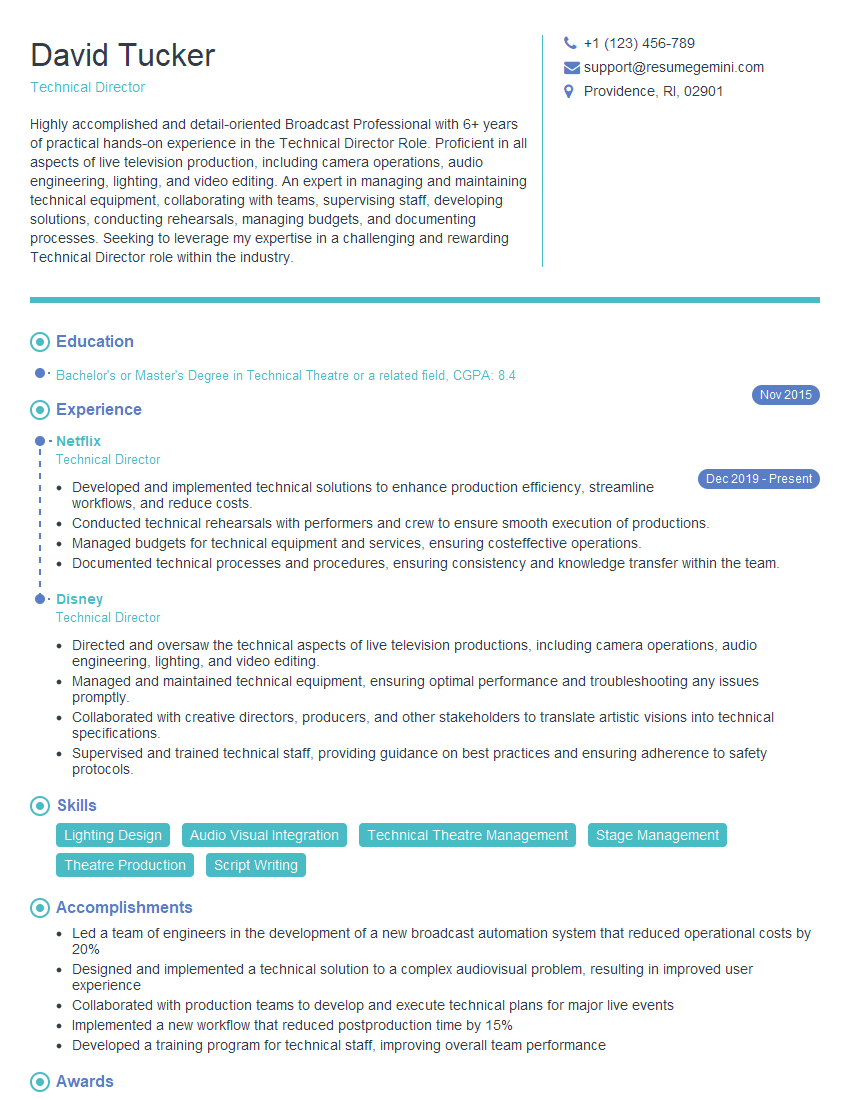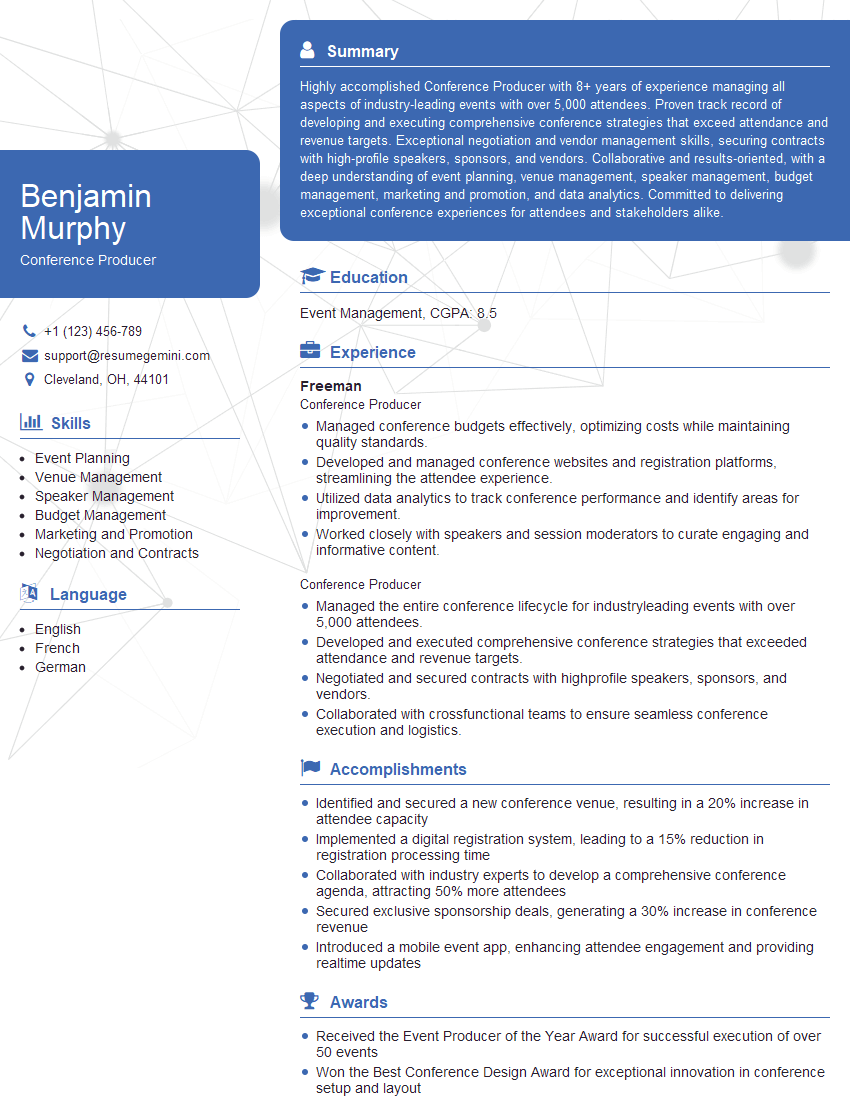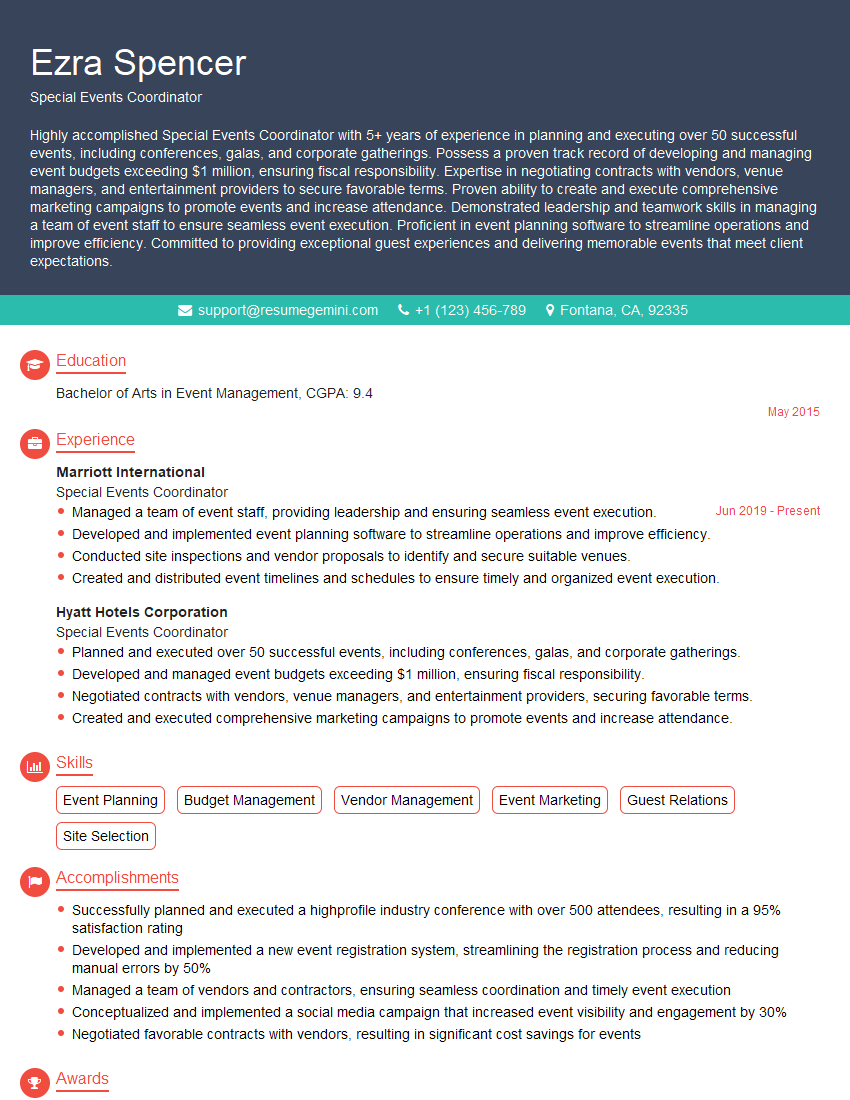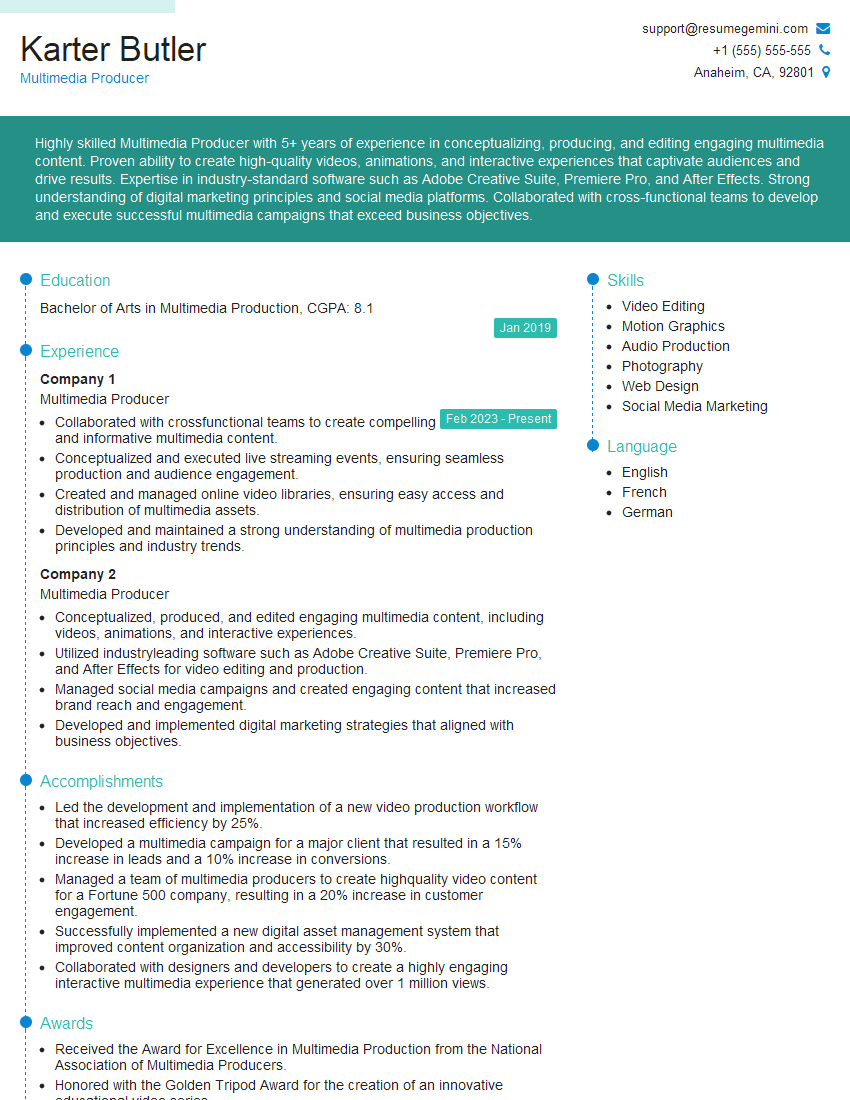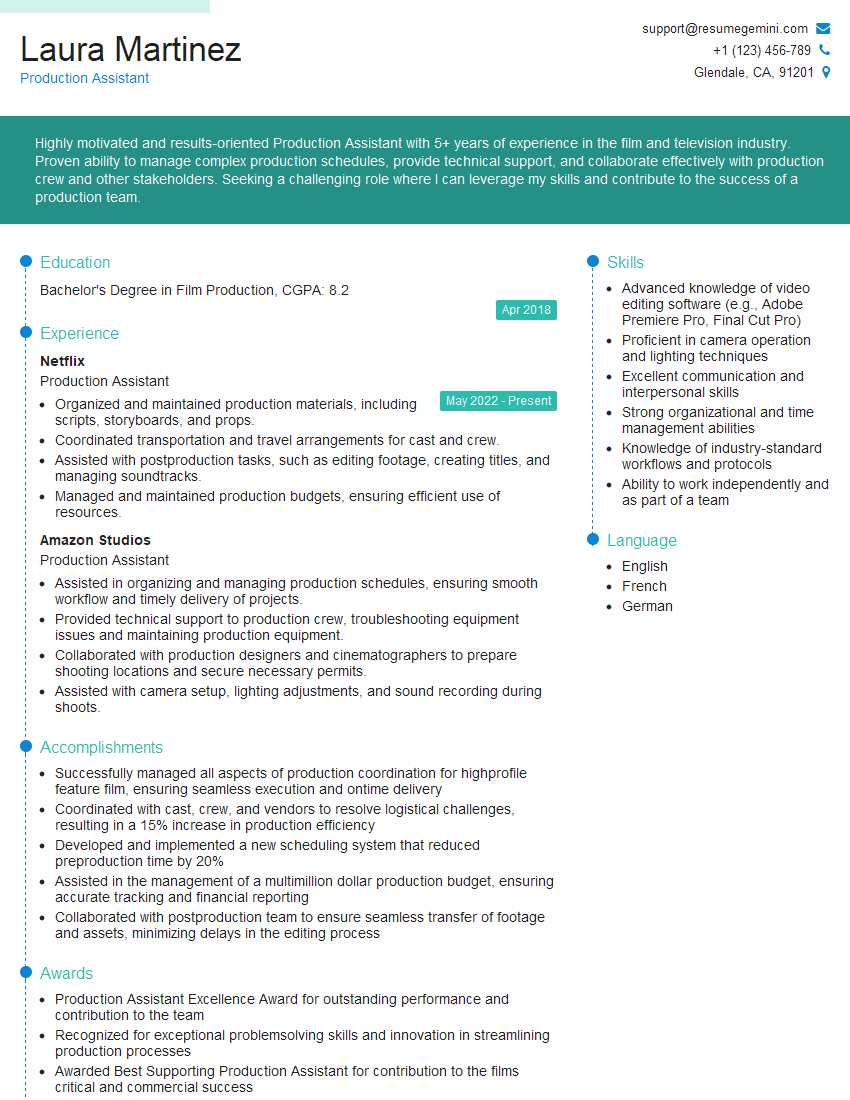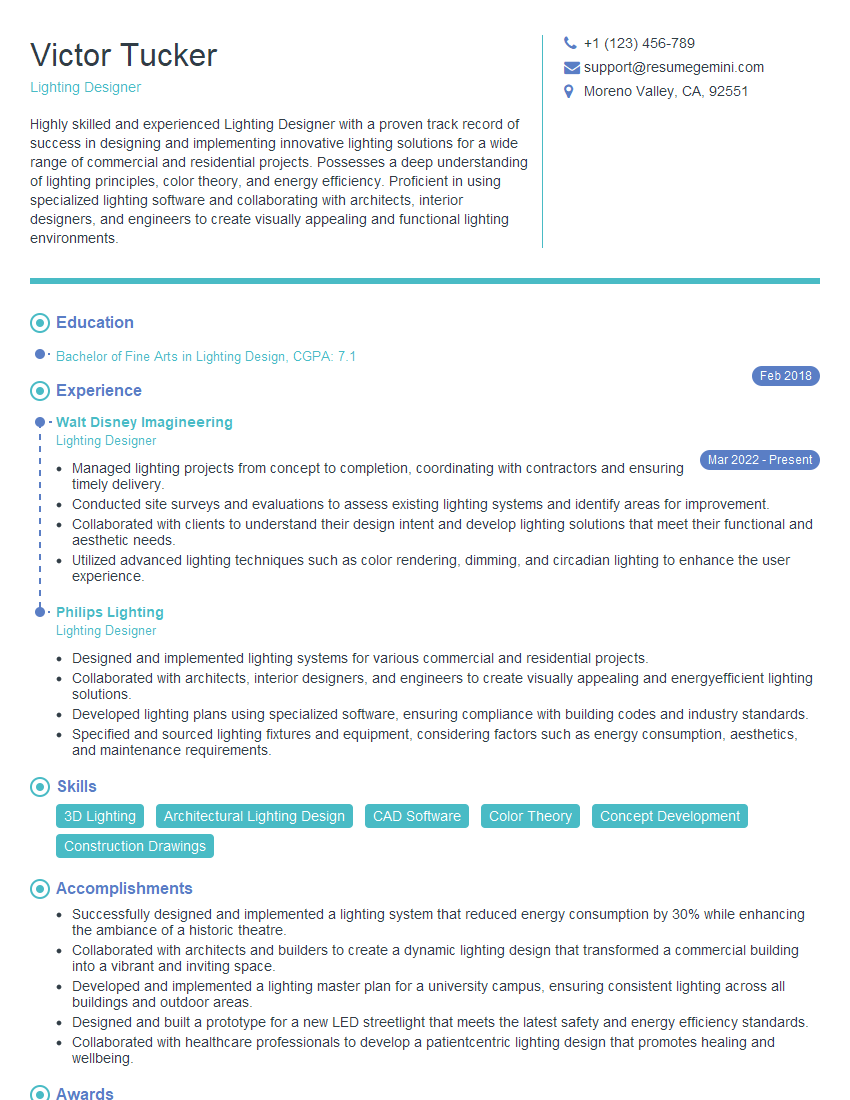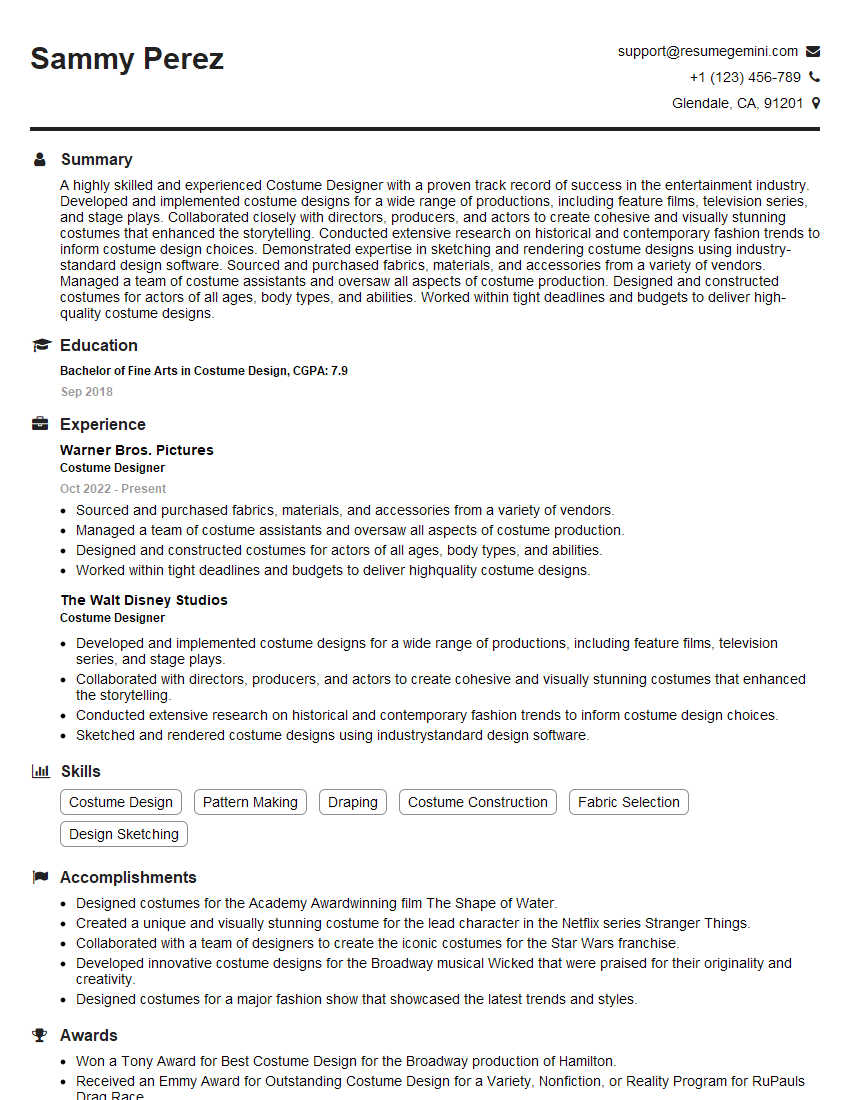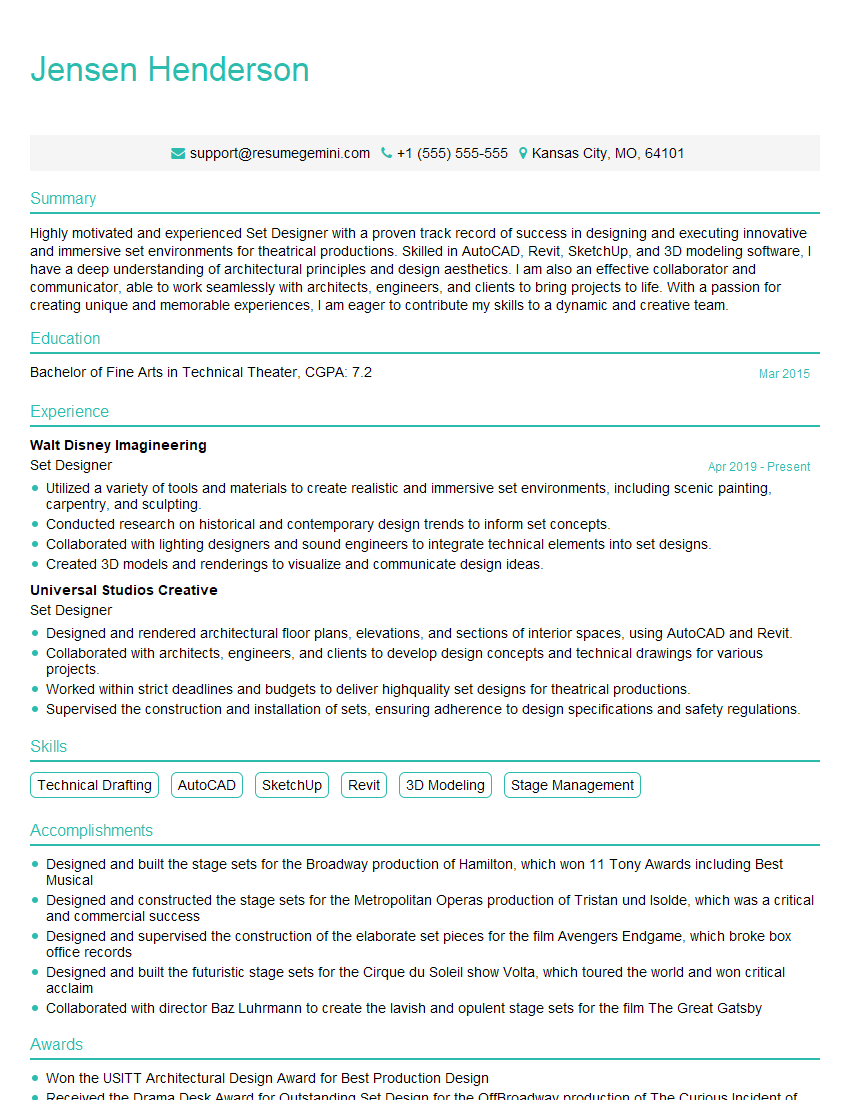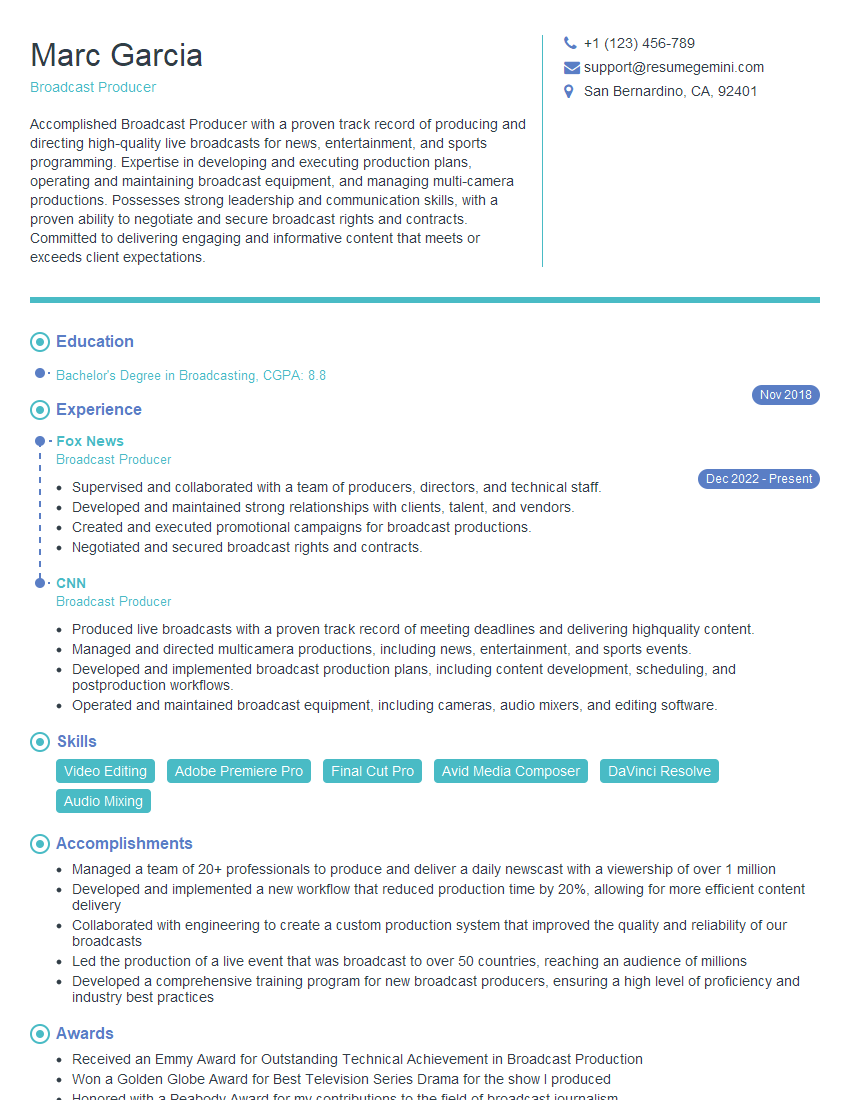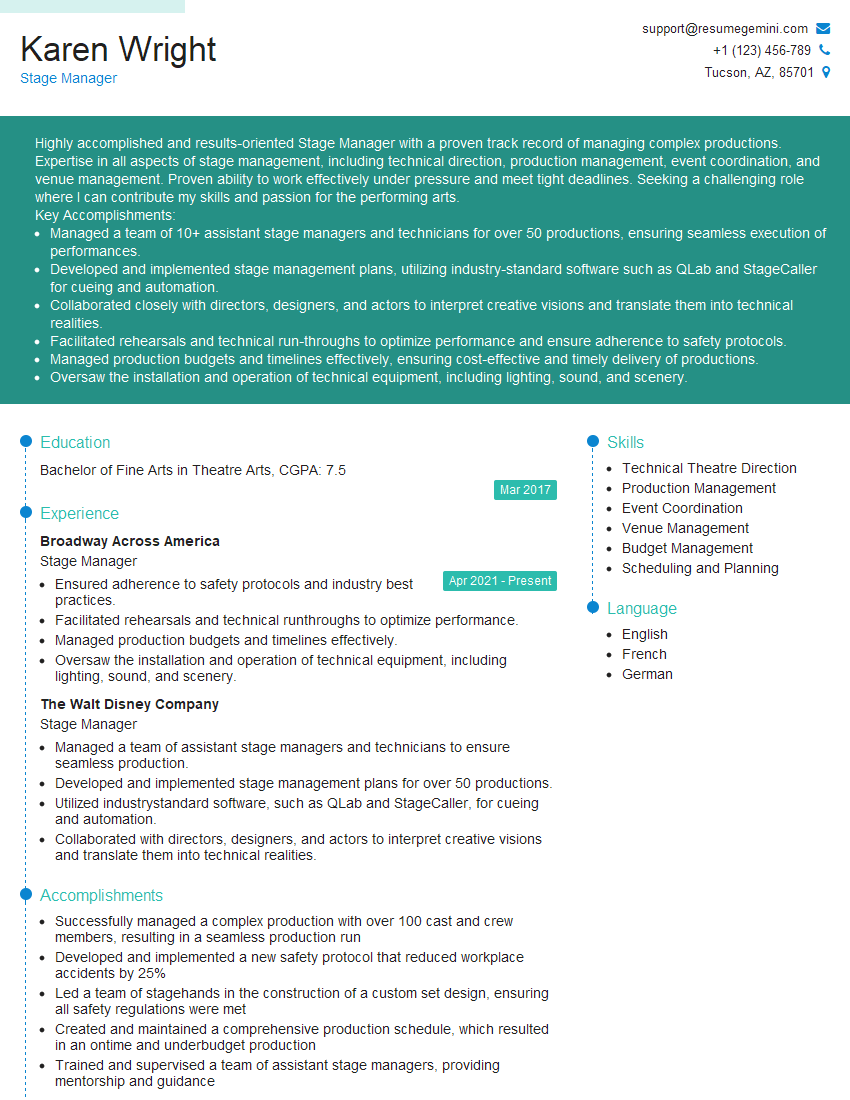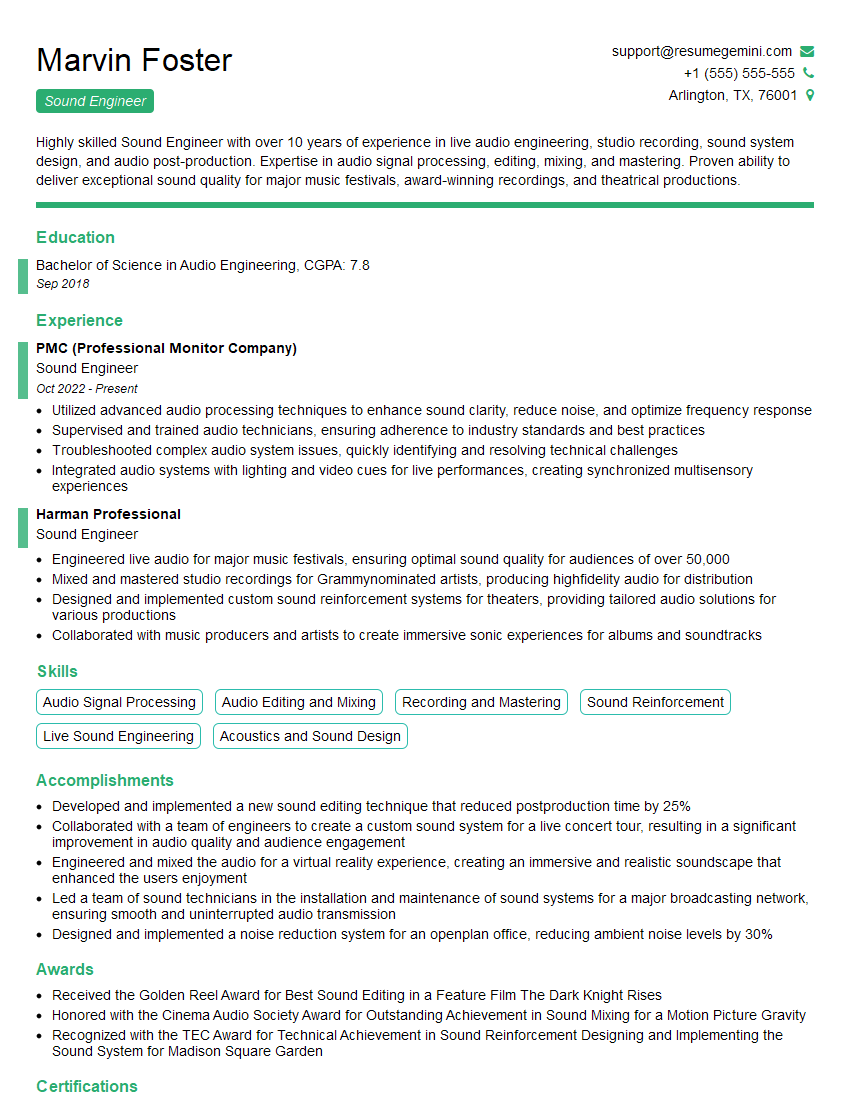Interviews are more than just a Q&A session—they’re a chance to prove your worth. This blog dives into essential Show Preparation and Presentation interview questions and expert tips to help you align your answers with what hiring managers are looking for. Start preparing to shine!
Questions Asked in Show Preparation and Presentation Interview
Q 1. Describe your experience in managing the logistics of a large-scale event.
Managing the logistics of a large-scale event requires meticulous planning and execution. It’s like orchestrating a complex symphony – each instrument (team, resource) needs to be in perfect harmony. My approach involves a phased methodology:
- Pre-Production: This phase involves securing the venue, negotiating contracts with vendors (catering, security, AV), managing budgets, and creating detailed schedules. For example, in a recent corporate conference with 500 attendees, I negotiated favorable rates with the hotel and coordinated catering menus to cater to diverse dietary needs.
- Production: During this phase, I oversee the setup, rehearsals, and the actual event itself. This includes managing the on-site team, addressing any unforeseen issues, and ensuring everything runs smoothly. For instance, we had a last-minute change in speaker availability. I quickly rearranged the schedule and coordinated with the AV team to adjust the presentation slides.
- Post-Production: This involves dismantling the event setup, settling all invoices, conducting post-event evaluations, and gathering feedback. Analyzing post-event data helps in refining logistics for future events. For example, we surveyed attendees on their experience, identifying areas for improvement in future conferences.
Effective communication and proactive problem-solving are crucial throughout all phases. I leverage project management software to track progress, manage tasks, and maintain communication across all teams.
Q 2. Explain your process for developing a presentation timeline.
Developing a presentation timeline requires a backward planning approach, starting with the event’s end time and working backward. Think of it as building a house – you need a solid foundation before adding the walls and roof.
- Define Key Milestones: First, list all critical activities, like speaker briefings, content creation, rehearsal times, and technical setup.
- Allocate Time: Assign realistic timeframes to each activity. Consider potential delays and buffer time. For a 1-hour presentation, you might need 2 weeks for content creation, 1 day for rehearsals, and 2 hours for technical setup.
- Sequence Activities: Arrange activities in a logical sequence considering dependencies. For example, content creation must precede rehearsals.
- Create a Visual Timeline: Use a Gantt chart or project management software (e.g., Asana, Trello) to visualize the timeline, making it easy to track progress and identify potential conflicts.
- Regular Check-Ins: Schedule regular meetings with the team to track progress and address any roadblocks.
A well-defined timeline minimizes stress and maximizes efficiency, ensuring a smooth and successful presentation.
Q 3. How do you handle unexpected technical difficulties during a live show?
Unexpected technical difficulties are inevitable in live shows. Preparation and a cool head are key. My strategy involves:
- Proactive Prevention: Thorough pre-show technical rehearsals help identify and fix potential problems beforehand. For example, testing all equipment and backups.
- Redundancy: Having backup equipment and plans is crucial. This could include a backup projector, microphone, or even a contingency presentation in case of complete failure.
- Quick Problem Solving: If problems arise, the team needs to react quickly and effectively. Clear roles and responsibilities are essential. I’ve trained my teams to troubleshoot common issues efficiently, saving valuable time.
- Graceful Degradation: If a major issue arises that can’t be fixed immediately, having alternative plans (e.g., a simplified presentation) minimizes disruptions. This allows for a graceful transition, rather than a complete shutdown.
- Post-Event Analysis: Analyzing what went wrong helps to prevent similar issues in the future.
Think of it like a race car driver – they have backup systems and practice handling unexpected situations to maintain control.
Q 4. What software or tools are you proficient in for show preparation?
Proficiency in various software and tools is vital for show preparation. I’m proficient in:
- Presentation Software: PowerPoint, Keynote, Google Slides for creating engaging visuals.
- Video Editing Software: Adobe Premiere Pro, Final Cut Pro for creating and editing videos.
- Graphic Design Software: Adobe Photoshop, Illustrator for designing visuals.
- Project Management Software: Asana, Trello for organizing tasks and tracking progress.
- AV Control Systems: Familiarity with various AV control systems for managing audio-visual aspects of the show.
My expertise extends to utilizing these tools to create professional, engaging, and technically flawless presentations.
Q 5. Describe your experience in coordinating with various teams (e.g., AV, lighting, stagehands).
Coordinating with various teams is crucial for a successful show. My approach centers on clear communication, collaborative planning, and establishing shared goals.
- Pre-Production Meetings: Regular meetings with AV, lighting, and stagehands teams are crucial to align expectations and address any potential conflicts.
- Detailed Run-of-Show: A comprehensive run-of-show document outlines every aspect of the event, including timing, responsibilities, and contact information for each team.
- Open Communication Channels: Establishing clear communication channels (email, instant messaging, dedicated communication platform) enables prompt issue resolution and fosters a collaborative environment.
- Respectful Collaboration: Understanding each team’s expertise and respecting their contributions is vital for building a positive working relationship. For example, actively soliciting feedback from the lighting director on how best to integrate the lighting with the presentation narrative.
Successful coordination relies on trust, clear communication, and mutual respect, resulting in a seamless and impactful show.
Q 6. How do you ensure the visual elements of a presentation are consistent with its message?
Visual consistency is paramount to reinforcing a presentation’s message. It’s about creating a unified and memorable experience for the audience. I ensure consistency by:
- Developing a Style Guide: This document outlines the presentation’s visual identity, including color palette, fonts, imagery style, and overall aesthetic. For example, I might choose a minimalist design for a technology presentation and a more vibrant style for a creative event.
- Using a Template: Consistent templates for slides ensure uniformity across the presentation. This maintains a professional look and prevents visual clutter.
- Careful Image Selection: Imagery must align with the message, avoiding irrelevant or distracting visuals. High-quality images enhance professionalism and engagement.
- Consistent Branding: Integrating consistent branding elements (logo, colors) reinforces brand identity and creates a cohesive message.
- Regular Reviews: Reviewing the presentation design regularly throughout the development process ensures consistency and avoids last-minute alterations.
By maintaining visual consistency, we strengthen the impact of the message and create a positive and memorable experience for the audience.
Q 7. What is your approach to budgeting for a show or presentation?
Budgeting for a show or presentation requires careful planning and detailed estimations. It’s like building a house – you need to know the cost of every material before you start construction. My approach involves:
- Detailed Breakdown: Categorizing all expenses (venue rental, AV equipment, talent fees, marketing, catering, etc.) is essential.
- Research and Comparisons: Obtaining quotes from multiple vendors allows for comparison and selection of cost-effective options. For example, I’ll compare rental rates for audio equipment from multiple vendors to ensure I secure the best deal.
- Contingency Planning: Including a contingency buffer (10-15%) in the budget to handle unforeseen costs is crucial.
- Tracking Expenses: Maintaining detailed records of all expenses ensures transparency and aids in financial management.
- Post-Event Analysis: Comparing actual costs with the budget identifies areas for cost optimization in future events. This data informs future budgeting, leading to improved cost efficiency.
A well-managed budget prevents financial overruns and ensures the show remains within allocated resources.
Q 8. How do you prioritize tasks and manage your time effectively during show preparation?
Effective show preparation hinges on meticulous task prioritization and time management. I utilize a combination of techniques, starting with a detailed project breakdown. This involves creating a comprehensive timeline, identifying all tasks (from securing permits to final rehearsals), and assigning deadlines to each. I then leverage project management tools like Trello or Asana to visualize the workflow, track progress, and assign responsibilities to team members. Prioritization follows a clear methodology: I focus first on critical path tasks – those that directly impact the show’s success and have dependencies that influence subsequent steps. For instance, securing a venue or finalizing contracts precedes designing stage lighting. After critical path items, I address tasks based on urgency and importance, using a matrix that categorizes them (urgent/important, important/not urgent, etc.). Regular progress meetings and adjustments are crucial to adapt to unforeseen delays or changing priorities. This proactive approach ensures no task is overlooked and the entire process remains aligned with the show’s timeline.
Q 9. Explain your experience in troubleshooting audio/visual equipment.
Troubleshooting audio/visual (A/V) equipment is a critical part of my role. My experience spans various scenarios, from minor glitches to major malfunctions. My approach is systematic: I always begin by identifying the problem precisely. Is there no sound? Is the image distorted? Then, I systematically check the most likely causes. For audio issues, this might include verifying cable connections, checking power sources, testing microphones, and inspecting the audio mixer settings. For video, it could mean reviewing input sources, adjusting projector settings, or checking for signal degradation. I’m proficient in using various testing tools, including multimeters and signal analyzers. I always have a backup plan – extra microphones, cables, and even a secondary projector – ready to deploy if a primary system fails. For complex issues, I’m not afraid to consult with technical specialists. One memorable instance involved a sudden power outage mid-show. Thanks to a pre-arranged backup generator and a quick-thinking crew, the show experienced minimal disruption, demonstrating the importance of preparedness and teamwork in A/V troubleshooting.
Q 10. Describe your method for selecting appropriate music or sound effects for a presentation.
Selecting music or sound effects for a presentation requires understanding the presentation’s theme, target audience, and desired emotional impact. The process begins with brainstorming and researching potential audio options. I explore royalty-free music libraries like PremiumBeat or Epidemic Sound to find tracks that fit the tone. I consider the pacing – upbeat music for energetic segments, calming music for reflective ones. Sound effects are chosen strategically to enhance specific moments. For example, a dramatic sting might emphasize a key point, while subtle background sounds can create ambience. I always test audio clips in the actual presentation environment to ensure clarity and volume levels are appropriate. I’m mindful of copyright issues and always obtain necessary licenses for any copyrighted material. The selection process is iterative; I often experiment with different audio options before settling on the final choices. In a recent presentation about technological innovation, I used a futuristic-sounding track to highlight new advancements, contrasting it with a more classical piece during a retrospective segment.
Q 11. How do you ensure the safety of performers and audience members during an event?
Ensuring the safety of performers and audience members is paramount. My safety procedures begin with a thorough risk assessment, identifying potential hazards such as stage design, lighting rigs, electrical equipment, and crowd management. I collaborate with venue security and emergency services to develop comprehensive emergency plans, including evacuation procedures and communication strategies. We conduct regular safety checks of the venue and equipment before and during the show, following established industry best practices and adhering to all relevant regulations. Appropriate signage and lighting are used to guide audience members, and crowd control measures are implemented to manage high-traffic areas. Performers are briefed on safety protocols and are provided with necessary safety equipment if required (e.g., harnesses for aerial acts). In the event of an emergency, my team and I are trained to respond swiftly and efficiently, ensuring everyone is evacuated safely and accounted for. Proper first aid provision is always ensured. Detailed emergency contact lists are readily available to all involved.
Q 12. Describe a time you had to adapt quickly to a change in plans during a live show.
During a live music performance, our headlining act fell ill just hours before the show. This required immediate improvisation. We had a backup plan in place for technical issues, but not for a performer’s sudden unavailability. Quickly, we activated our ‘Plan B’, which involved contacting a local band who had a similar musical style. I coordinated with the venue management, sound engineers, and the substitute band to adapt the stage setup, sound check, and stage times. This necessitated clear and concise communication and a willingness to adjust the setlist. The transition was not without challenges, but thanks to the team’s collaborative spirit and my ability to delegate tasks effectively, we managed to present a seamless and enjoyable show. The audience appreciated our resourcefulness, and we received positive feedback regarding the substitute band’s performance. This experience highlighted the importance of maintaining flexible plans and fostering teamwork under pressure.
Q 13. How do you incorporate audience interaction into a presentation effectively?
Effective audience interaction enhances engagement and creates a memorable experience. I incorporate audience interaction strategically, tailoring it to the presentation’s content and the audience’s demographics. Techniques include incorporating Q&A sessions, polls or quizzes using audience response systems, interactive games or activities, and inviting audience participation through storytelling or group discussions. For larger audiences, I might use social media hashtags to encourage real-time feedback and online interaction. Before incorporating interactions, I consider the presentation’s objectives and the best methods to meet them. For a recent product launch, we conducted a live Q&A session on social media, allowing for direct engagement with prospective customers. The use of polls to gauge audience preferences regarding product features proved invaluable for understanding customer needs.
Q 14. What are your preferred methods for gathering and organizing presentation materials?
My preferred method for gathering and organizing presentation materials is a highly structured approach that combines both digital and physical elements. I begin with a central repository, usually a cloud-based service like Google Drive or Dropbox, to store all relevant documents, images, videos, and audio files. Within this repository, I create a folder structure reflecting the presentation’s outline, making retrieval easy. I use project management tools to track assets, progress, and deadlines. I also create detailed checklists and running notes during the research and development phases, ensuring no detail is overlooked. For physical materials like props or handouts, I maintain a physical inventory to ensure I have all necessary items. I prioritize clear labeling and consistent file-naming conventions across all materials. This organizational approach ensures efficient access to information, minimizes time spent searching, and facilitates seamless collaboration with the team.
Q 15. Explain your experience with various presentation formats (e.g., keynote, PowerPoint, Prezi).
My experience spans a wide range of presentation software, each with its own strengths and weaknesses. PowerPoint remains the industry standard, offering a robust feature set and widespread compatibility. I’m adept at creating visually compelling and information-rich presentations using its various tools, including animations, transitions, and charts. Keynote, Apple’s presentation software, excels in its user-friendly interface and stunning visual effects; I’ve leveraged its capabilities for creating modern, engaging presentations, particularly for clients who prefer a more minimalist and elegant aesthetic. Prezi, with its non-linear presentation style, offers a unique approach to storytelling, which I’ve utilized effectively for projects requiring a more dynamic and less structured presentation flow – for example, presenting complex data interrelationships or fostering audience engagement in creative workshops. I select the software based on the specific project needs, audience expectations, and the desired level of interactivity.
For instance, for a technical presentation to engineers, I might choose PowerPoint for its detailed charting capabilities and clear data visualization tools. For a more creative marketing pitch to a design-focused team, I’d choose Keynote for its sleek aesthetic and easy implementation of visually impactful design elements. Finally, for a brainstorming session with a diverse group, Prezi’s ability to zoom and pan across ideas could be particularly effective.
Career Expert Tips:
- Ace those interviews! Prepare effectively by reviewing the Top 50 Most Common Interview Questions on ResumeGemini.
- Navigate your job search with confidence! Explore a wide range of Career Tips on ResumeGemini. Learn about common challenges and recommendations to overcome them.
- Craft the perfect resume! Master the Art of Resume Writing with ResumeGemini’s guide. Showcase your unique qualifications and achievements effectively.
- Don’t miss out on holiday savings! Build your dream resume with ResumeGemini’s ATS optimized templates.
Q 16. How do you ensure accessibility in your show preparation for people with disabilities?
Accessibility is paramount. I ensure all presentations are compliant with WCAG (Web Content Accessibility Guidelines) best practices. This involves using sufficient color contrast between text and background, providing alternative text for images (alt text), ensuring proper captioning and transcripts for any audio or video content, and using clear, concise language. I also consider font size and style, ensuring readability for individuals with visual impairments. For presentations with interactive elements, I focus on keyboard navigation and screen reader compatibility. Furthermore, I always offer alternative formats such as large print handouts or braille versions if needed, tailoring the approach to the specific disability and the individual’s requirements.
For example, if incorporating a video, I would ensure it has accurate closed captioning. If using a complex chart, I would include a simpler, more accessible table to convey the same information. I actively consult with accessibility experts and individuals with disabilities during the planning stages to ensure a truly inclusive experience.
Q 17. Describe your understanding of copyright and licensing concerning show elements.
Understanding copyright and licensing is critical. I meticulously source all show elements – images, music, video clips, and fonts – ensuring they are either in the public domain, properly licensed for commercial use, or have explicit permission from the copyright holder. I maintain detailed records of all licenses and permissions acquired, including source links and license agreements. This includes adhering to Creative Commons licenses and understanding the limitations and permissions associated with different types of licenses. I also educate my team members on copyright law and the importance of ethical sourcing. Failing to comply can lead to legal issues and damage the reputation of the production.
I often use royalty-free stock photo and music websites, carefully verifying the licenses associated with each asset. If using custom-created artwork or music, I always obtain written permission and retain copies of the agreements. This proactive approach prevents costly mistakes and maintains the integrity of the production.
Q 18. How do you evaluate the success of a show or presentation after it concludes?
Evaluating a show’s success involves a multifaceted approach. Immediately following the event, I gather quantitative data such as audience attendance, feedback surveys, and social media engagement. This provides a general sense of audience reach and initial reception. However, a truly comprehensive evaluation goes beyond immediate metrics. I also consider qualitative feedback gathered through post-event interviews with attendees, team members, and stakeholders. This allows for a deeper understanding of audience engagement, the clarity of the message, and the overall effectiveness of the presentation. This also includes analyzing whether the presentation achieved its stated objectives, such as driving sales, increasing brand awareness, or educating the audience.
For example, a low attendance might indicate poor marketing; negative feedback on the clarity of the content could prompt revisions for future presentations. By combining quantitative and qualitative data, I identify both strengths and weaknesses, facilitating continuous improvement in future productions.
Q 19. What is your experience with risk assessment and mitigation during event planning?
Risk assessment is an integral part of my planning process. I use a systematic approach, identifying potential risks across various categories: technical issues (equipment failure, software glitches), logistical challenges (venue problems, transportation delays), health and safety concerns (audience safety, emergency procedures), and even unforeseen events (weather, cancellations). For each identified risk, I assess its likelihood and potential impact. Based on this assessment, I develop mitigation strategies, creating contingency plans to address each potential problem. This includes having backup equipment, alternative venues, and clearly defined emergency protocols.
For example, if there’s a risk of inclement weather affecting an outdoor event, the mitigation strategy could involve securing an indoor backup venue or developing a plan to reschedule the event. Regular communication with the venue and all stakeholders is crucial throughout the process.
Q 20. Describe your experience with creating and managing a project budget.
Budget management involves detailed planning and meticulous tracking. I start by creating a comprehensive budget proposal that encompasses all projected expenses, from venue rental and equipment hire to talent fees and marketing costs. This budget is broken down into distinct categories for easier tracking and analysis. I utilize project management software to monitor expenses against the allocated budget throughout the production lifecycle. This allows for early identification of any potential budget overruns and provides opportunities for proactive adjustments. Regular financial reports are generated to keep stakeholders informed of the project’s financial health.
Transparency is key; I regularly share updated budget reports with my team and stakeholders, allowing for open communication and collaborative decision-making regarding potential cost-saving measures. I also strive to negotiate favorable rates with vendors and explore cost-effective alternatives where appropriate.
Q 21. How do you handle difficult personalities or conflicts within a production team?
Handling difficult personalities or conflicts requires diplomacy, clear communication, and a focus on collaboration. I foster a positive and respectful team environment from the outset, setting clear expectations and communication protocols. If conflict arises, I facilitate open and honest dialogue between the involved parties, acting as a neutral mediator. I encourage individuals to express their concerns and perspectives respectfully, focusing on finding mutually agreeable solutions. In some instances, involving HR or senior management may be necessary. The goal is to resolve the conflict constructively, preserving team cohesion and ensuring the project’s progress.
My approach emphasizes active listening and empathetic understanding. I strive to identify the root cause of the conflict, rather than simply addressing the symptoms. I also work to ensure that each team member feels valued and respected, regardless of their personality or role in the production.
Q 22. How do you maintain a high level of attention to detail in a high-pressure environment?
Maintaining attention to detail under pressure is crucial for successful show preparation. It’s like being a surgeon – every small detail matters. My approach is multi-faceted. Firstly, I use detailed checklists for every stage, from scriptwriting and prop management to lighting cues and audio levels. This ensures nothing is overlooked. Secondly, I employ a meticulous review process. I conduct multiple rehearsals, each time scrutinizing every aspect. This includes checking transitions, timings, and even the placement of commas in the script. Thirdly, I build in buffer time. Knowing that unexpected issues can arise (a malfunctioning microphone, a last-minute change in the program), I allocate extra time to anticipate and address these. Finally, I leverage technology to help me stay organized. Project management software, combined with cloud-based document sharing, allows for collaboration and keeps track of every detail. This systematic and proactive approach helps me navigate high-pressure environments effectively, minimizing errors and maximizing quality.
Q 23. How do you ensure that all aspects of a show or presentation meet deadlines?
Meeting deadlines in show preparation requires a proactive and organized approach. It’s similar to managing a complex construction project where every element must align perfectly. I begin with a detailed project plan, breaking down the show into smaller, manageable tasks with clearly defined deadlines. I use Gantt charts to visualize the timeline and dependencies between tasks. This allows me to identify potential bottlenecks early on and adjust the schedule as needed. Regular progress meetings with the team are essential to monitor progress, identify challenges, and ensure everyone is on track. Transparent communication is key – I keep all stakeholders updated on progress, potential roadblocks, and any necessary adjustments to the timeline. Finally, I build in contingency plans to account for unforeseen circumstances. This includes having backup equipment, alternative solutions, and extra time allocated for potential delays. This combination of planning, communication, and proactive risk management ensures all aspects of the show are completed on time and to a high standard.
Q 24. Describe your experience with creating engaging and visually appealing presentations.
Creating engaging and visually appealing presentations is a passion of mine. I believe a great presentation is a story well told, visually. For example, in a recent corporate presentation for a tech company, we used minimal text, instead opting for high-quality visuals and animated infographics to explain complex technical concepts. This kept the audience engaged and made the information more easily digestible. Another time, for a historical presentation, we incorporated period imagery and subtle animation to create a sense of immersion. My process involves deep understanding of the target audience, careful selection of visual elements – including high-resolution images, compelling video clips, and engaging animations – and a focus on strong storytelling. I employ design principles such as the rule of thirds and consistent branding to ensure visual appeal and cohesiveness. I also utilize presentation software like PowerPoint or Keynote effectively, using transitions and animations strategically to enhance engagement without overwhelming the audience. The key is to let the visuals support the narrative, not distract from it.
Q 25. What is your understanding of different lighting techniques and their applications?
Lighting is crucial for setting the mood and enhancing the visual impact of any show or presentation. It’s like painting with light. I’m familiar with various lighting techniques, including:
- Ambient Lighting: Provides general illumination, setting the overall tone.
- Key Lighting: The primary light source, illuminating the subject.
- Fill Lighting: Softens shadows created by the key light, balancing the exposure.
- Backlighting: Separates the subject from the background, adding depth and dimension.
- Accent Lighting: Highlights specific areas or objects, drawing attention to key elements.
The application of these techniques depends entirely on the context. For a dramatic stage performance, you might utilize high-contrast lighting to create suspense. A corporate presentation might benefit from softer, more even lighting to create a professional atmosphere. I always consider the color temperature, intensity, and direction of the light to achieve the desired aesthetic and enhance the overall impact of the show.
Q 26. How do you incorporate feedback to improve your show preparation and presentation skills?
Incorporating feedback is integral to continuous improvement. I see feedback as a gift, providing valuable insights into areas where I can refine my skills. I actively solicit feedback from colleagues, audience members, and clients through surveys, informal discussions, and formal reviews. I pay close attention to both positive and constructive criticism. For instance, if feedback suggests my presentations are too technical, I adapt by simplifying complex terms and focusing on visuals. If the pace is considered too slow, I adjust the timing and incorporate interactive elements. I document this feedback systematically, noting areas for improvement and the actions I’ll take to address them. This proactive approach, coupled with consistent self-reflection, enables me to continuously hone my show preparation and presentation skills, becoming more effective and engaging with each project.
Q 27. Describe your familiarity with various audio recording and mixing techniques.
My experience encompasses various audio recording and mixing techniques. This involves a deep understanding of microphones, audio interfaces, digital audio workstations (DAWs), and mixing consoles. I’m proficient in using different microphone types – condenser, dynamic, lavalier – for optimal sound capture based on the specific application. I’m also skilled in using DAWs like Pro Tools or Logic Pro X to edit, process, and mix audio, ensuring clarity, balance, and optimal sound quality. For instance, I’ve worked on projects requiring sophisticated multi-track recording and mixing, incorporating sound effects and music to enhance the audio landscape. I’m adept at noise reduction, equalization, compression, and other audio processing techniques to achieve professional-sounding results. My understanding extends to acoustic treatment of spaces, recognizing how room acoustics can impact sound quality and employing methods to minimize unwanted reflections and echoes.
Q 28. How do you ensure the smooth transition between different segments of a show?
Smooth transitions are essential for maintaining audience engagement and creating a cohesive viewing experience. It’s like weaving a tapestry, seamlessly connecting different threads. I plan transitions carefully, ensuring a logical flow between segments. This may involve using video transitions, audio cues, or even carefully choreographed movements on stage. For example, a smooth transition from a high-energy musical performance to a more reflective segment might involve a gradual fade-out of the music, accompanied by a subtle change in lighting, before introducing the next segment. I also use transitional elements such as short video clips, voice-overs, or visual graphics to bridge segments and maintain continuity. Rehearsals are critical; we meticulously rehearse transitions to ensure they are seamless and timed perfectly. The goal is to create a cohesive and captivating experience, devoid of jarring breaks or awkward silences.
Key Topics to Learn for Show Preparation and Presentation Interview
- Understanding the Audience: Analyzing target demographics, preferences, and expectations to tailor your presentation effectively. Practical application: Developing audience personas and crafting messaging to resonate with each.
- Storytelling & Narrative Structure: Structuring your presentation with a compelling narrative arc, incorporating engaging anecdotes and examples to maintain audience interest. Practical application: Practicing different narrative structures and receiving feedback on their effectiveness.
- Visual Communication & Design: Creating visually appealing and informative slides, charts, and other visuals that enhance understanding and engagement. Practical application: Experimenting with different design software and styles to determine what best suits the content and audience.
- Content Development & Research: Conducting thorough research to support your claims and ensure accuracy, while presenting information concisely and clearly. Practical application: Developing a robust research plan and utilizing diverse research methods.
- Rehearsal & Delivery Techniques: Mastering effective delivery techniques, including vocal projection, body language, and handling Q&A sessions confidently. Practical application: Practicing in front of a mirror or test audience and incorporating feedback to refine your delivery.
- Technical Proficiency: Demonstrating familiarity with relevant presentation software (PowerPoint, Keynote, etc.) and troubleshooting any technical difficulties effectively. Practical application: Becoming proficient in the features and functions of multiple presentation software packages.
- Adaptability and Improvisation: Showcasing the ability to adapt to unexpected situations, handle audience questions skillfully, and improvise gracefully if needed. Practical application: Role-playing challenging scenarios and practicing responses to potential questions.
Next Steps
Mastering Show Preparation and Presentation is crucial for career advancement in many fields, demonstrating valuable communication and presentation skills. A strong resume showcasing these abilities is vital. To significantly increase your chances of landing your dream role, create an ATS-friendly resume that highlights your relevant experience and skills effectively. ResumeGemini is a trusted resource for building professional, impactful resumes. We provide examples of resumes tailored to Show Preparation and Presentation roles to help you craft your own compelling application materials. Take advantage of these resources to showcase your skills and propel your career forward.
Explore more articles
Users Rating of Our Blogs
Share Your Experience
We value your feedback! Please rate our content and share your thoughts (optional).
What Readers Say About Our Blog
Hi, I represent an SEO company that specialises in getting you AI citations and higher rankings on Google. I’d like to offer you a 100% free SEO audit for your website. Would you be interested?
good
